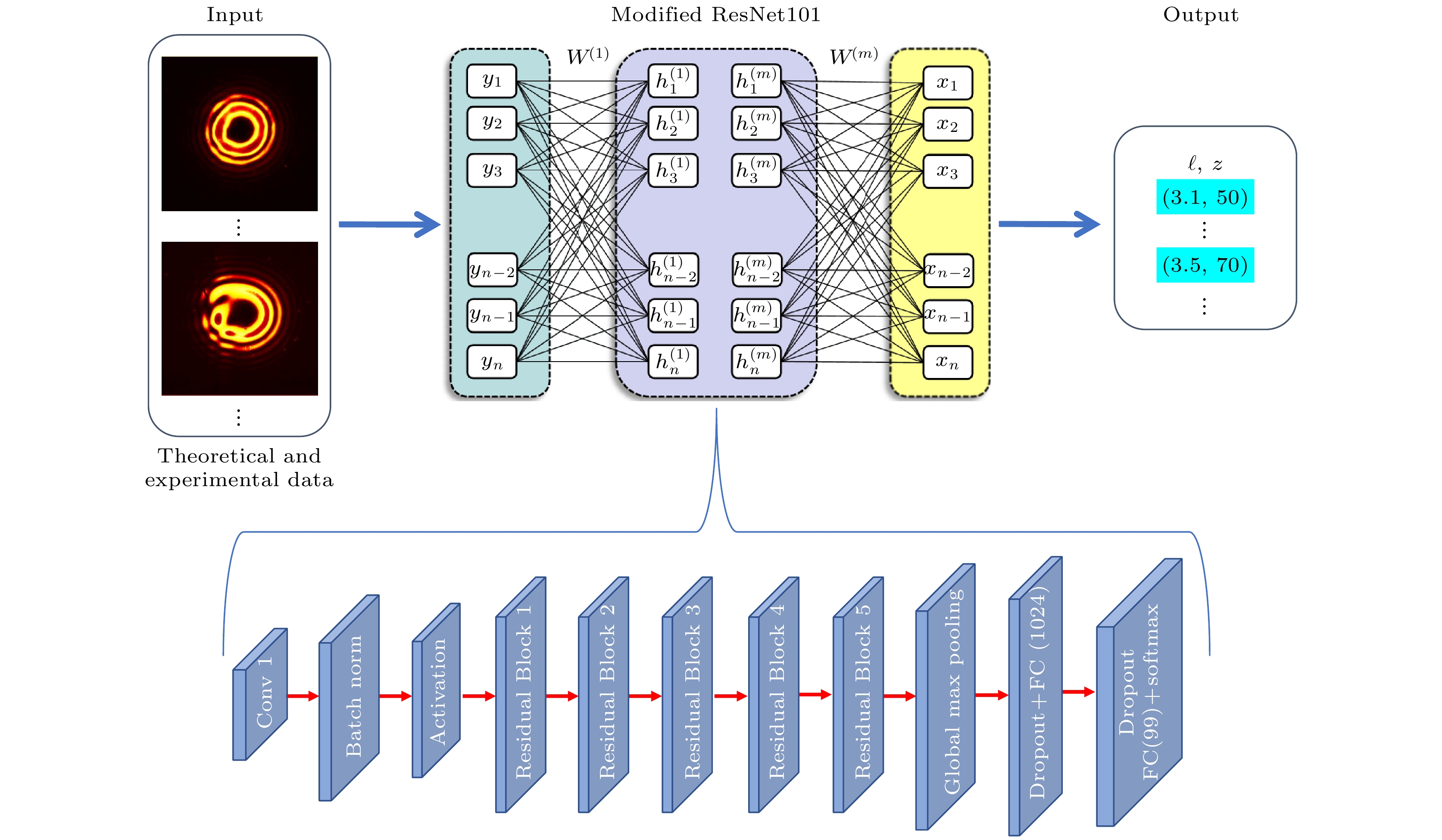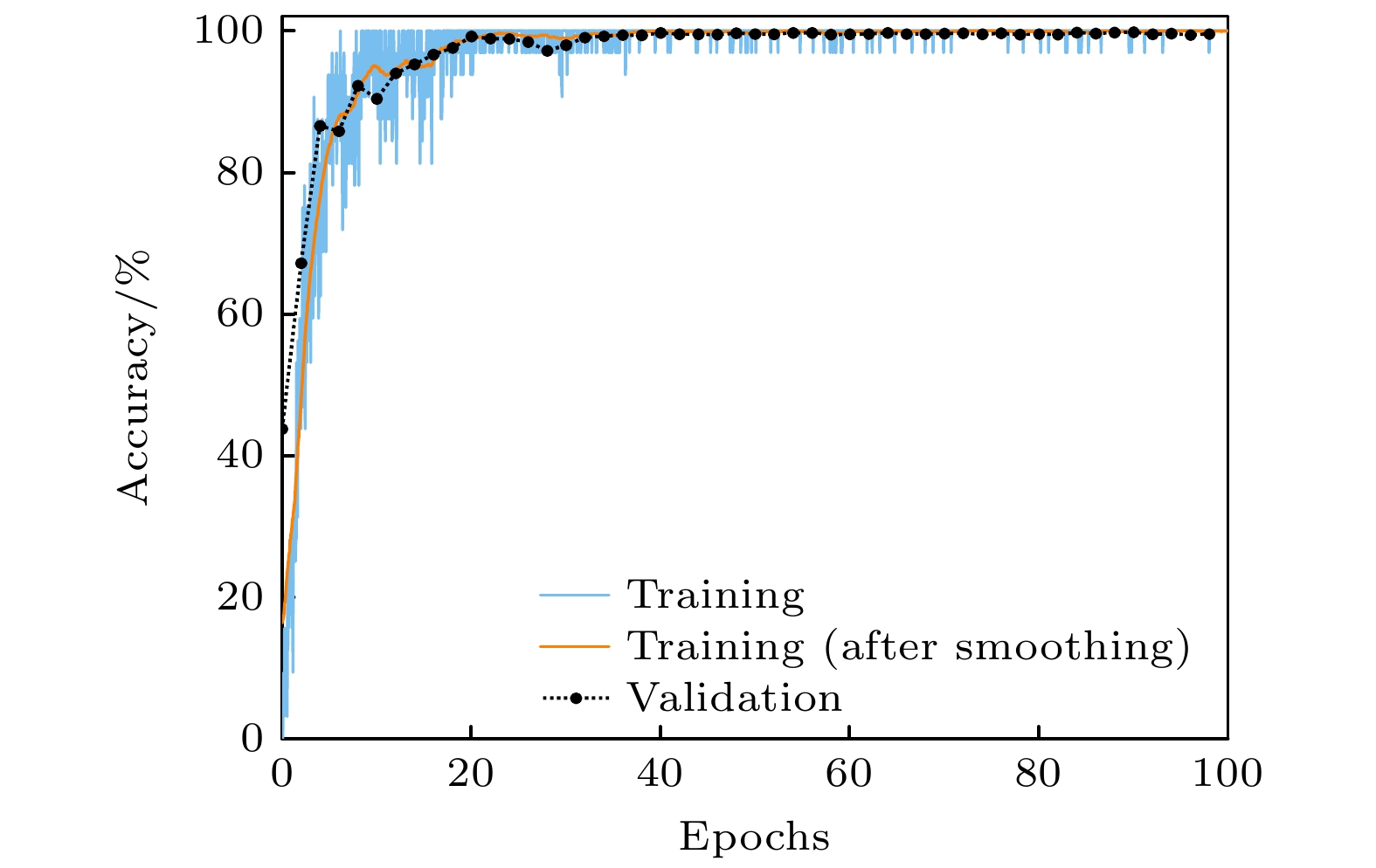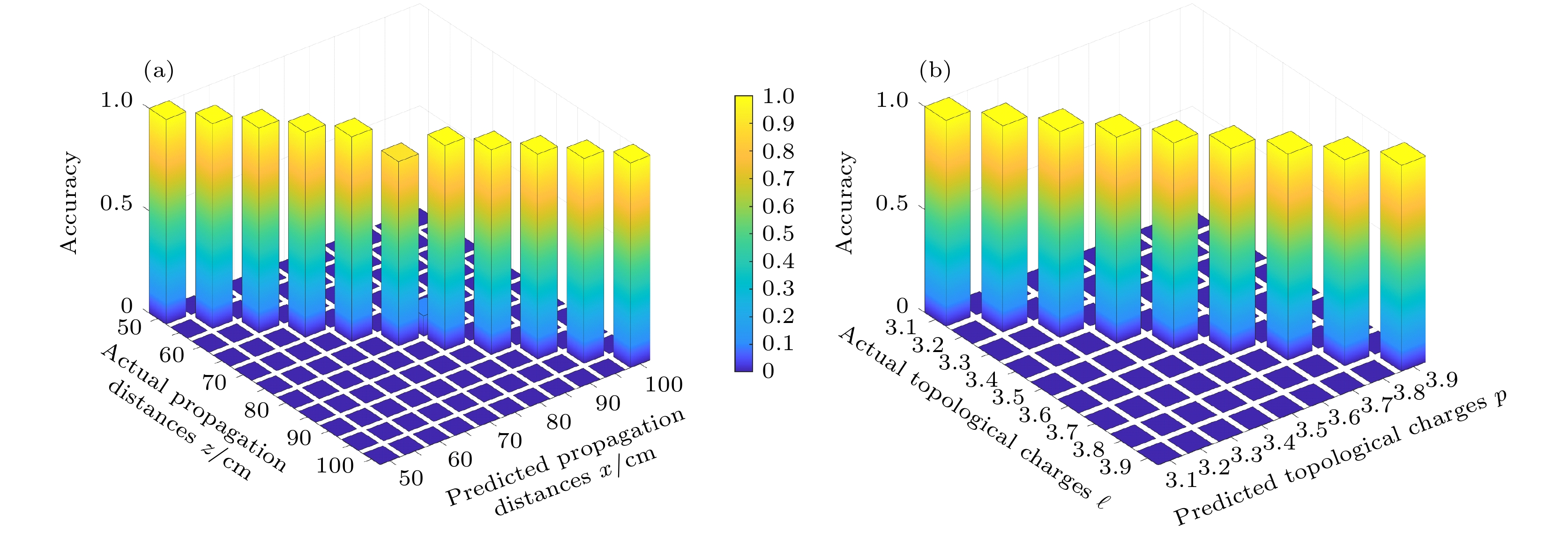-
分数阶涡旋光束具有分数轨道角动量(fractional orbital angular momentum, FOAM)模式, 理论上可以无限增加传输容量, 因此在光通信领域具有巨大的应用前景. 然而, 分数阶涡旋光束在自由空间传播时, 螺旋相位的不连续性使其在实际应用中容易受到衍射的影响, 进而影响FOAM阶次识别的准确度, 严重制约基于FOAM的实际应用. 如何实现有衍射条件下的分数阶涡旋光的机器学习识别, 目前仍是一个亟需解决且少见诸报道的问题. 本文提出一种基于残差网络(residual network, ResNet)的深度学习(deep learning, DL)方法, 用于精确识别分数阶涡旋光衍射过程的传播距离和拓扑荷值. 实验结果表明, 该方法可以在湍流条件下识别传播距离为100 cm, 间隔为5 cm, 模式间隔为0.1的FOAM模式, 准确率为99.69%. 该技术有助于推动FOAM模式在测距、光通信、微粒子操作等领域的实际应用.Fractional-order vortex beams possess fractional orbital angular momentum (FOAM) modes, which theoretically have the potential to increase transmission capacity infinitely. Therefore, they have significant application prospects in the fields of measurement, optical communication and microparticle manipulation. However, when fractional-order vortex beams propagate in free space, the discontinuity of the helical phase makes them susceptible to diffraction in practical applications, thereby affecting the accuracy of OAM mode recognition and severely limiting the use of FOAM-based optical communication. Achieving machine learning recognition of fractional-order vortex beams under diffraction conditions is currently an urgent and unreported issue. Based on ResNetA, a deep learning (DL) method of accurately recognizing the propagation distance and topological charge of fractional-order vortex beam diffraction process is proposed in this work. Utilizing both experimentally measured and numerically simulated intensity distributions, a dataset of vortex beam diffraction intensity patterns in atmospheric turbulence environments is created. An improved 101-layer ResNet structure based on transfer learning is employed to achieve accurate and efficient recognition of the FOAM model at different propagation distances. Experimental results show that the proposed method can accurately recognize FOAM modes with a propagation distance of 100 cm, a spacing of 5 cm, and a mode spacing of 0.1 under turbulent conditions, with an accuracy of 99.69%. This method considers the effect of atmospheric turbulence during spatial transmission, allowing the recognition scheme to achieve high accuracy even in special environments. It has the ability to distinguish ultra-fine FOAM modes and propagation distances, which cannot be achieved by traditional methods. This technology can be applied to multidimensional encoding and sensing measurements based on FOAM beam.
-
Keywords:
- fractional vortex beams /
- machine learning /
- atmosphere turbulence /
- residual network
[1] Shen Y, Wang X, Xie Z, Min C, Fu X, Liu Q, Gong M, Yuan X 2019 Light Sci. Appl. 8 90
 Google Scholar
Google Scholar
[2] Bai Y, Lü H, Fu X, Yang Y 2022 Chin. Opt. Lett. 20 012601
 Google Scholar
Google Scholar
[3] Zhang H, Zeng J, Lu X, Wang Z, Zhao C, Cai Y 2022 Nanophotonics 11 241
 Google Scholar
Google Scholar
[4] Chen X, Wang S, You C, Magaña-Loaiza O S, Jin R B 2022 Phys. Rev. A 106 033521
 Google Scholar
Google Scholar
[5] Guo Z, Chang Z, Meng J, An M, Jia J, Zhao Z, Wang X, Zhang P 2022 Appl. Opt. 61 5269
 Google Scholar
Google Scholar
[6] Nye J F, Berry M V 1974 Proc. R. Soc. London, Ser. A 336 165
[7] Brygndahl O 1973 J. Opt. Soc. Am. 63 1098
 Google Scholar
Google Scholar
[8] Allen L, Beijersbergen M W, Spreeuw R J C, Woerdman J P 1992 Phys. Rev. A 45 8185
 Google Scholar
Google Scholar
[9] Senthilkumaran P, Sato S, Masajada J 2012 Int. J. Opt. 2012 1
 Google Scholar
Google Scholar
[10] Wang J, Yang J Y, Fazal I M, et al. 2012 Nat. Photonics 6 488
 Google Scholar
Google Scholar
[11] Kotlyar V V, Kovalev A A, Nalimov A G, Porfirev A P 2020 Phys. Rev. A 102 023516
 Google Scholar
Google Scholar
[12] Zhu L, Tang M, Li H, Tai Y, Li X 2021 Nanophotonics 10 2487
 Google Scholar
Google Scholar
[13] Nicolas A, Veissier L, Giner L, Giacobino E, Maxein D, Laurat J 2014 Nat. Photonics 8 234
 Google Scholar
Google Scholar
[14] Otte E, Rosales-Guzmán C, Ndagano B, Denz C, Forbes A 2018 Light Sci. Appl. 7 18009
 Google Scholar
Google Scholar
[15] Bu X, Zhang Z, Chen L, Liang X, Tang H, Wang X 2018 IEEE Antennas Wirel. Propag. Lett. 17 764
 Google Scholar
Google Scholar
[16] Li X, Tai Y, Lü F, Nie Z 2015 Opt. Commun. 334 235
 Google Scholar
Google Scholar
[17] Leach J, Courtial J, Skeldon K, Barnett S M, Franke-Arnold S, Padgett M J 2004 Phys. Rev. Lett. 92 013601
 Google Scholar
Google Scholar
[18] Beijersbergen M W, Allen L, Van der Veen H, Woerdman J 1993 Opt. Commun. 96 123
 Google Scholar
Google Scholar
[19] Zhou J, Zhang W, Chen L 2016 Appl. Phys. Lett. 108 111108
 Google Scholar
Google Scholar
[20] Krenn M, Fickler R, Fink M, Handsteiner J, Malik M, Scheidl T, Ursin R, Zeilinger A 2014 New J. Phys. 16 113028
 Google Scholar
Google Scholar
[21] Doster T, Watnik A T 2017 Appl. Opt. 56 3386
 Google Scholar
Google Scholar
[22] Liu Z, Yan S, Liu H, Chen X 2019 Phys. Rev. Lett. 123 183902
 Google Scholar
Google Scholar
[23] Jing G, Chen L, Wang P, Xiong W, Huang Z, Liu J, Chen Y, Li Y, Fan D, Chen S 2021 Results Phys. 28 104619
 Google Scholar
Google Scholar
[24] Guo H, Qiu X, Chen L 2022 Phys. Rev. Appl. 17 054019
 Google Scholar
Google Scholar
[25] Gao H, Zhang Z, Yang Y 2023 Appl. Opt. 62 5707
 Google Scholar
Google Scholar
[26] Wu Y, Wang A, Zhu L 2023 Opt. Express 31 36078
 Google Scholar
Google Scholar
[27] Zhao Y, Zhong X, Ren G, He S, Wu Z 2017 Opt. Commun. 387 432
 Google Scholar
Google Scholar
[28] Zhou Z Y, Zhu Z H, Shi B S 2023 Quantum Eng. 2023 4589181
[29] Collins S A 1970 J. Opt. Soc. Am. 60 1168
 Google Scholar
Google Scholar
[30] Bos J P, Roggemann M C, Gudimetla V S R 2015 Appl. Opt. 54 2039
 Google Scholar
Google Scholar
[31] Glindemann A, Lane R, Dainty J 1993 J. Mod. Opt. 40 2381
 Google Scholar
Google Scholar
[32] Bhusal N, Lohani S, You C, Hong M, Fabre J, Zhao P, Knutson E M, Glasser R T, Magaña-Loaiza O S 2021 Adv. Quantum Technol. 4 2000103
 Google Scholar
Google Scholar
[33] Lü H, Guo Y, Yang Z X, Ding C, Cai W H, You C, Jin R B 2022 Front. Phys. 10 843932
[34] Fernando B, Habrard A, Sebban M, Tuytelaars T 2014 arXiv: 1409.5241 [cs.CV]
[35] Krizhevsky A, Sutskever I, Hinton G E 2017 Commun. ACM 60 84
 Google Scholar
Google Scholar
[36] Zhang Z, Sabuncu M 2018 Advances in Neural Information Processing Systems 31 8778
[37] Kingma D P, Ba J 2014 arXiv: 1412.6980 [cs.LG]
-
图 2 不同拓扑荷数$\ell $和不同传播距离z的涡旋光束空间分布 (a)无湍流影响的无畸变模态的空间分布; (b)大气湍流影响的畸变模态的空间分布. 第一行和第三行是实验获得的图像, 第二行和第四行是理论模拟的图像
Fig. 2. Spatial profiles of vortex beams with different topological charges $\ell $ and different propagation distances z: (a) Spatial distribution of distortionless modes without turbulence; (b) the spatial distribution of distortion modes affected by atmospheric turbulence. The first and third rows are the images acquired from the experiment, and the second and fourth rows represent the theoretically simulate.
图 5 训练后的深度学习算法的混淆矩阵 (a) $ \ell=3.5$时, 预测传播距离与真实传播距离之间的归一化混淆矩阵; (b) $ z=75$ cm时$\ell $的预测值和$\ell $的真实值之间的归一化混淆矩阵
Fig. 5. The confusion matrix of our trained deep learning algorithm: (a) The normalized confusion matrix between the predicted propagation distance and the true propagation distance for $ \ell=3.5$; (b) normalized confusion matrix between predicted $\ell $ values and true $\ell $ values for z = 75 cm.
-
[1] Shen Y, Wang X, Xie Z, Min C, Fu X, Liu Q, Gong M, Yuan X 2019 Light Sci. Appl. 8 90
 Google Scholar
Google Scholar
[2] Bai Y, Lü H, Fu X, Yang Y 2022 Chin. Opt. Lett. 20 012601
 Google Scholar
Google Scholar
[3] Zhang H, Zeng J, Lu X, Wang Z, Zhao C, Cai Y 2022 Nanophotonics 11 241
 Google Scholar
Google Scholar
[4] Chen X, Wang S, You C, Magaña-Loaiza O S, Jin R B 2022 Phys. Rev. A 106 033521
 Google Scholar
Google Scholar
[5] Guo Z, Chang Z, Meng J, An M, Jia J, Zhao Z, Wang X, Zhang P 2022 Appl. Opt. 61 5269
 Google Scholar
Google Scholar
[6] Nye J F, Berry M V 1974 Proc. R. Soc. London, Ser. A 336 165
[7] Brygndahl O 1973 J. Opt. Soc. Am. 63 1098
 Google Scholar
Google Scholar
[8] Allen L, Beijersbergen M W, Spreeuw R J C, Woerdman J P 1992 Phys. Rev. A 45 8185
 Google Scholar
Google Scholar
[9] Senthilkumaran P, Sato S, Masajada J 2012 Int. J. Opt. 2012 1
 Google Scholar
Google Scholar
[10] Wang J, Yang J Y, Fazal I M, et al. 2012 Nat. Photonics 6 488
 Google Scholar
Google Scholar
[11] Kotlyar V V, Kovalev A A, Nalimov A G, Porfirev A P 2020 Phys. Rev. A 102 023516
 Google Scholar
Google Scholar
[12] Zhu L, Tang M, Li H, Tai Y, Li X 2021 Nanophotonics 10 2487
 Google Scholar
Google Scholar
[13] Nicolas A, Veissier L, Giner L, Giacobino E, Maxein D, Laurat J 2014 Nat. Photonics 8 234
 Google Scholar
Google Scholar
[14] Otte E, Rosales-Guzmán C, Ndagano B, Denz C, Forbes A 2018 Light Sci. Appl. 7 18009
 Google Scholar
Google Scholar
[15] Bu X, Zhang Z, Chen L, Liang X, Tang H, Wang X 2018 IEEE Antennas Wirel. Propag. Lett. 17 764
 Google Scholar
Google Scholar
[16] Li X, Tai Y, Lü F, Nie Z 2015 Opt. Commun. 334 235
 Google Scholar
Google Scholar
[17] Leach J, Courtial J, Skeldon K, Barnett S M, Franke-Arnold S, Padgett M J 2004 Phys. Rev. Lett. 92 013601
 Google Scholar
Google Scholar
[18] Beijersbergen M W, Allen L, Van der Veen H, Woerdman J 1993 Opt. Commun. 96 123
 Google Scholar
Google Scholar
[19] Zhou J, Zhang W, Chen L 2016 Appl. Phys. Lett. 108 111108
 Google Scholar
Google Scholar
[20] Krenn M, Fickler R, Fink M, Handsteiner J, Malik M, Scheidl T, Ursin R, Zeilinger A 2014 New J. Phys. 16 113028
 Google Scholar
Google Scholar
[21] Doster T, Watnik A T 2017 Appl. Opt. 56 3386
 Google Scholar
Google Scholar
[22] Liu Z, Yan S, Liu H, Chen X 2019 Phys. Rev. Lett. 123 183902
 Google Scholar
Google Scholar
[23] Jing G, Chen L, Wang P, Xiong W, Huang Z, Liu J, Chen Y, Li Y, Fan D, Chen S 2021 Results Phys. 28 104619
 Google Scholar
Google Scholar
[24] Guo H, Qiu X, Chen L 2022 Phys. Rev. Appl. 17 054019
 Google Scholar
Google Scholar
[25] Gao H, Zhang Z, Yang Y 2023 Appl. Opt. 62 5707
 Google Scholar
Google Scholar
[26] Wu Y, Wang A, Zhu L 2023 Opt. Express 31 36078
 Google Scholar
Google Scholar
[27] Zhao Y, Zhong X, Ren G, He S, Wu Z 2017 Opt. Commun. 387 432
 Google Scholar
Google Scholar
[28] Zhou Z Y, Zhu Z H, Shi B S 2023 Quantum Eng. 2023 4589181
[29] Collins S A 1970 J. Opt. Soc. Am. 60 1168
 Google Scholar
Google Scholar
[30] Bos J P, Roggemann M C, Gudimetla V S R 2015 Appl. Opt. 54 2039
 Google Scholar
Google Scholar
[31] Glindemann A, Lane R, Dainty J 1993 J. Mod. Opt. 40 2381
 Google Scholar
Google Scholar
[32] Bhusal N, Lohani S, You C, Hong M, Fabre J, Zhao P, Knutson E M, Glasser R T, Magaña-Loaiza O S 2021 Adv. Quantum Technol. 4 2000103
 Google Scholar
Google Scholar
[33] Lü H, Guo Y, Yang Z X, Ding C, Cai W H, You C, Jin R B 2022 Front. Phys. 10 843932
[34] Fernando B, Habrard A, Sebban M, Tuytelaars T 2014 arXiv: 1409.5241 [cs.CV]
[35] Krizhevsky A, Sutskever I, Hinton G E 2017 Commun. ACM 60 84
 Google Scholar
Google Scholar
[36] Zhang Z, Sabuncu M 2018 Advances in Neural Information Processing Systems 31 8778
[37] Kingma D P, Ba J 2014 arXiv: 1412.6980 [cs.LG]
计量
- 文章访问数: 4117
- PDF下载量: 173
- 被引次数: 0













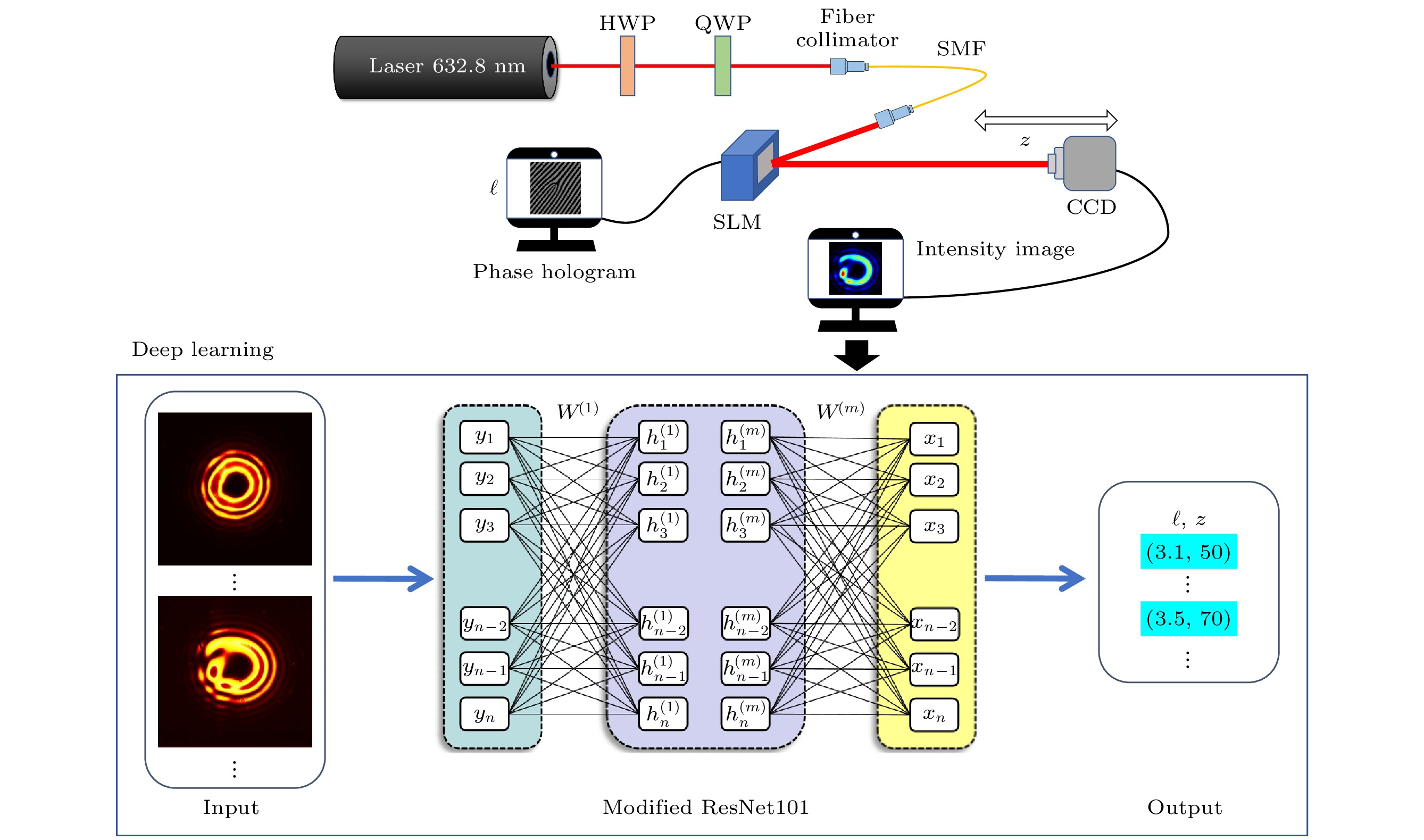
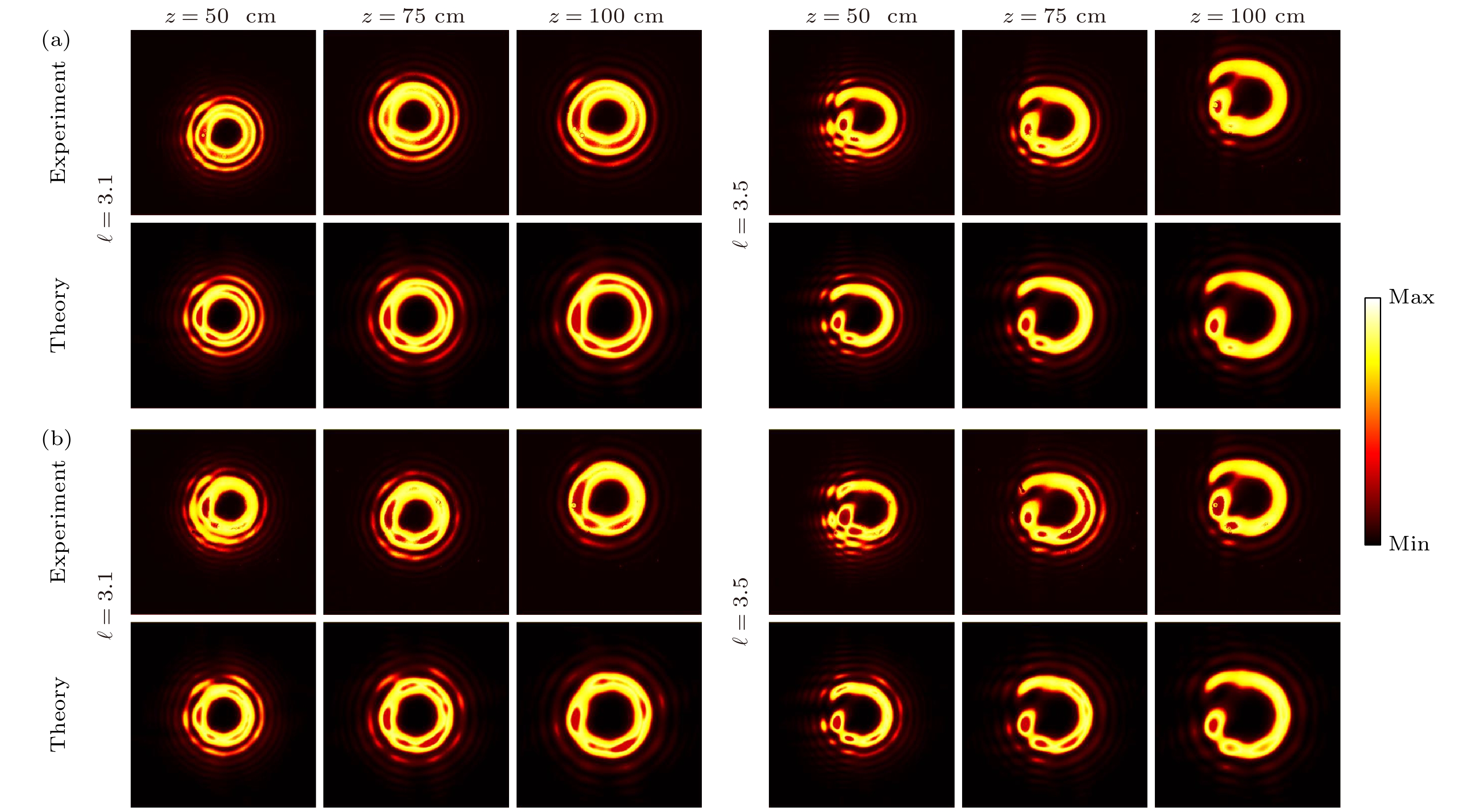
 下载:
下载:

